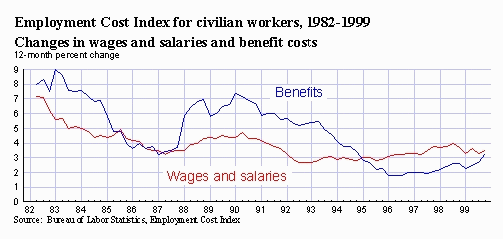March 6 - ECI Becoming Another Botched Indicator?
AsJohn Crudelefrom the NY Post pointed out last week, we could be being mislead
by the sly methods in which CPI is calculated. But the numbers the Bureau of Labor Statistics could be hiding from us in PPI and CPI could only be the tip of the iceberg. A quick glance at the
employment cost index tells us that a reliable reading in ECI may be many months away as the BLS first tackles bonuses and then stock options.
BLS: "In June 2000, the Bureau of Labor Statistics plans to expand the definition of nonproduction bonuses in the ECI to represent better the compensation packages
offered to employees… the ECI will include hiring and referral bonuses.". As recently as 1998 the BLS reported that the U.S. high-tech industry employees nearly 5 million people,
making it one of the nations largest industries. With this growth, particularly in the stocks of many of these companies, the proliferation of signing bonuses and stock options
has also grown thus nullifying some of the impact of companies having to increase wages to attract and keep employees. A report from National Center for Employee Ownership last October 1999 stated
"The average value of the most recent stock option
grants to nonmanagement employees (defined as the number of options granted times the share value on the
date of grant) was between $37,000 and $41,000 for professional and technical employees and $12,500 for administrative employees. These averages vary tremendously…".
Top researcher from the non-profitable NCOE Ryan Weeden went on to say
"Stock options have become a popular way to attract and retain not just top people, but all employees."
It is obvious the option values vary tremendously when you consider at the extreme end many internet
companies rely heavily if not solely on signing new talent by the use of stock options. Unlike signing
bonuses and referral fees stock options are typically not a one time event either, like many people think. Of the companies polled by the NCOE over 80% provided ongoing awards to nonmanagers, not just the one time
check.
Companies have seen and taken advantage of operating their daily business on the reliable shoulders of the
bull market by using option plans. In the early 90's there was less than 1 million Americans receiving stock options and today the estimates are a conservative
10 million. When considering the expansion of the high tech industry, which is the most option laden class, it is somewhat surprising to notice a vast amount of
money made by today's top professionals is completely disregarded by the BLS as any type of corporate cost.
The BLS may be figuring out what is really helping to keep surface costs low. They are now beginning to investigate.
BLS
"The Bureau of Labor Statistics is currently conducting research on stock option plans. This research
will be completed in stages. Beginning in early 2000, the BLS will conduct a test survey of the incidence of
stock option plans across all industries and occupations. The prevalence of these plans, based on test
results, and the potential impact on compensation costs will determine the next stage of research. The results of the incidence survey will be published in late 2000."
As long as the bull market keeps running one can only hope the BLS will catch up with the changing times to
give an honest depiction of what is really going on. Don't forget though, when the bull comes to a screeching halt the issuance of stock options will diminish quickly and new employees not tempted to work for an
average pay and paper dreams could be getting a raise in wages and salaries just when the economy seems to cooling down.
The labor market may not need slack in productivity or dip in the unemployment rate to grow even tighter.
Just calm the bull market and see what happens to the paper millionaires who need higher stock prices to keep
their standard of living alive. How productive would you be if a few bad sessions on Wall Street flushed your big paycheck on paper down the toilet?
|
